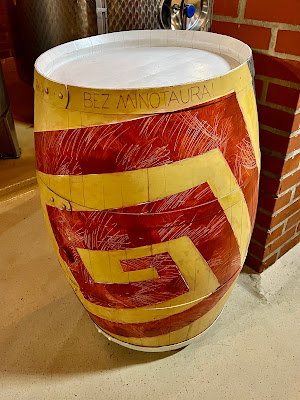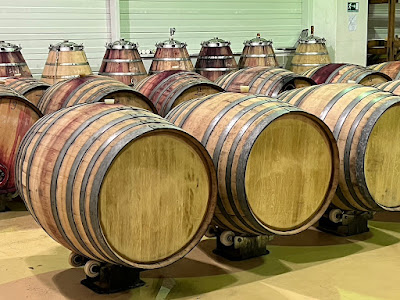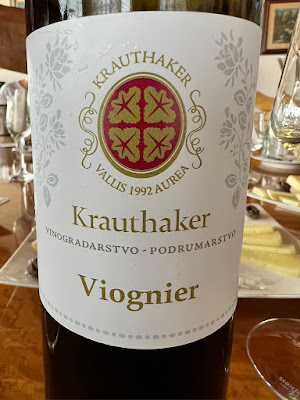The Krauthaker Winery was founded in 1992 by the famed Vlado Krauthaker, an agronomist and enologist, who had previously worked for about eighteen years, much of the time as their chief enologist, at the Kutjevo Winery. Thus, this year is the 30th anniversary of the establishment of Krauthaker Winery, and there is much reason to celebrate. When Vlado began his own winery, he started with only a single hectare of vineyards, truly a humble beginning. Now, he owns about 50 hectares of Croatian vineyards, with another 65 hectares in a cooperative.
Vlado was warm, hospitable, and down to earth, and you wouldn't have known from his easy demeanor that he was a legend in the Croatian wine industry. He was a humble winemaker, sharing the fruits of his skill, experimentation and labor, treating us as if we were family or close friends. The hours we spent with him passed so quickly, and every one of us was thoroughly impressed by all of it.
More decorated barrels.
We arrived at Krauthaker during the afternoon, meeting Martina Krauthaker, Vlado's daughter and also an enologist, and Ivan, Vlado's nephew and business manager. We toured the winery, visited the cellars, and then tasted some of their wines, including a few tank samples. Vlado joined us later during the tasting, and we later adjoined to their home for dinner, where the wine tasting continued....and continued.
Ivan would say, "Prepare your glasses," and then bring out another bottle of wine for us to sample. This mantra was repeated many times during the evening, and we never knew what intriguing new wine would then be poured in our glass.
Krauthaker is currently the second biggest private winery in Croatia, with a capacity of 1 Million liters, although they only produce about 600K liters. They built a new wine cellar about 12 years ago as they needed space for additional growth. Nearly all of the barrels in their cellars are Slavonian oak, with only a tiny percentage of French oak. The winery is located in the Kutjevo region, where there are a total of about 1700 hectares of vineyards and 25 private wineries. Of those wineries, only about 11 have tasting rooms, while only 1 has guest rooms and only 1 has a restaurant. We were told that Krauthaker will never open a restaurant or have guest rooms at their winery.
Their vineyards are located in the Požega Valley, on the slopes of the Krndija and Papuk Mountains at elevations ranging form 200-400 meters. As mentioned before, this region was known to the Romans as the Vallis Aurea, the "Golden Valley," due to the richness of the land for vineyards. In addition, the winery is located at the 45.3 degree parallel, placing it on the same latitude as famed wine regions including Bordeaux, Provence, Val du Rhone Valley, Piedmont, Veneto, and Oregon. This is an important fact, as it has led Vlado to experiment with grapes that grow on this parallel around the world. It was also noted that their region has more sun than some other Croatian areas, as well as less rain than Istria.
About ten hectares of their vineyards are narrow, so they use their six horses to plow that section. When the horses aren't plowing, the are sometimes used to pull several carriages that they also own.
About 70% of their production, totaling about 130K liters, is Graševina, and they make 8 different labels of this wine. For a long time, Graševina was simply considered to be an easy drinking wine but Vlado has been working on producing more quality Graševina, wines with personality, showing the potential of this grape. This sentiment has spread to a number of other Slavonian wineries, who are also trying to elevate Graševina, to ascertain its true potential in a wide variety of wine styles.
Krauthaker also possess a new crushing machine, a "balloon" which is gentler and better protects the aromatics of the grapes.
With their devotion to an exploration of Graševina, Vlado is also experimenting with many other grapes, trying to determine which grapes might grow best in the Kutjevo region. Currently their vineyards contain approximately 44 grape varieties, with 35 different labels on the market. It was noted that their most challenging grapes are Sauvignon Blanc (due to the heat of the region) and Pinot Noir.
They have introduced 11 new grapes to the region because of their experimentation. Many of the experimental grapes come from other regions on the 45th parallel. Out of all the grapes they grow, they will likely eliminate about ten of them, as not working out well, but they have plenty of choices for replacement grapes. With these experimental grapes, it takes about five years, from their first bottling, to receive certification to put the wines on the market. Vlado noted that the experimental grape which seems to possess the most promise is Manzoni Bianco, a white grape from the Veneto.
The front labels of many of their wines are fairly similar, differing mainly from the name of the grape, but the back labels have different colors. The from of the white labels though has a different flower than the other wines. Krauthaker exports about 25% of their wines, to 18 countries, mostly in Europe.
Martina poured us tank samples of a couple different Graševina wines, and you could detect the potential of these wines, with fresh and fruity flavors, but with some depth to them as well.
The 2021 Krauthaker Julija, is an Extra Sec Sparkling Wine, made from a blend of Yellow Muscat, White Muscat and Ottonel Muscat. Produced by the Charmat Method, with a 13% ABV, it was fresh, crisp, dry and fruity, with strong Muscat notes and small bubbles. A pleasant wine to start dinner or as an aperitif.
The 2021 Krauthaker Graševina Podgorje, with a 13% ABV, was fresh, crisp, and dry with tasty flavors of apples and citrus, with a hint of almonds. It had a nice richness to it, with a lengthy finish, with a touch of minerality. Delicious. More people need to embrace the delights of Graševina.
The 2021 Krauthaker Pinot Sivi (Gris) is made from their second largest varietal. It was also fresh and crisp, with flavors of melon, apple and a touch of lemon. Easy drinking and tasty, it would be fine on its own, or it would pair well with plenty of lighter dishes.
The 2020 Krauthaker Zelenac Kutjevo, with 13% ABV, is made from Zelenac, which is the Croatian name for the Austrian grasper Rotgipfler. This grape grows primarily in the Thermenregion of Austria, with tiny amounts in Croatia and Slovenia. Zelenac derives from the term "zeleni" which means "green." Krauthaker is the only Croatian wine that produces it as a single varietal, with a few other wineries that use it for blending. This was an intriguing wine, with a nice richness to the body, good acidity, peach and pear notes, with a hint of herbs. I was quite taken with this wine.
The 2019 Krauthaker Viognier, with a 13% ABV, was light and aromatic, with good acidity and a nice brightness.
The 2020 Krauthaker Graševina Mitrovac, with a 13.5% ABV, is made from 50+ year old vines in one of the best vineyard positions for Graševina. This was such a compelling wine, with an alluring aroma, and a complex and delicious taste. It was rich, with excellent acidity, more subtle fruit flavors, more savory notes, and a lingering, satisfying finish. Silky smooth on the palate, each taste brought something new to your mouth. Highly recommended!
The 2021 Krauthaker Sauvignon Vidim, with a 13% ABV, is made from French clones and the grapes underwent 5-10 hours of maceration. They used their new balloon press to preserve the aromatics. This was a very nice wine, with hints of grapefruit and lemon, some minerality, and a long finish. The Lufthansa airline bought 13-14K bottles of this wine.
The 2019 Krauthaker Chardonnay Rosenberg, with a 13% ABV, spent about 6-10 months in oak. It was smoky and spicy, with subdued fruit flavors, and was said that it ages well.
The 2019 Krauthaker Verduzzo, with a 14% ABV, is made from Verduzzo Friuliano which has been aged in oak and acacia barrels. With a smoky aroma, the palate presented flavors of pineapple and tropical fruit, with almost a milf sweetness to it. There was an herbal backbone as well, with good acidity, and a pleasing finish. Very intriguing wine.
The 2020 Krauthaker Frankovka, with a 14% ABV, was another excellent example of their varietal. With a dark red color, it was fresh and smooth, with restrained tannins, tasty black fruit flavors and a touch of smokiness.
The 2019 Krauthaker Pinot Crni (Noir), with a 13.5% ABV, was was another excellent example its its varietal, using clones from the Dijon region of France. With a lighter red color, it presented an appealing aroma, and on the palate it was smooth and elegant, with bright cherry flavors, a kiss of spice, and a lengthy finish. Delicious.
The 2020 Krauthaker Muškat Ruža, with a 13.5% ABV, is made from a grape that is known in northern Italy as Moscato Rosa Del Trentino, The actual origin of this grape is unknown, and it might be native to Dalmatia and not Italy. There are about three producers of this grape in Slavonia, most using it for a semi-sweet wine. Krauthaker has chosen to make a dry version, and only produced 200 bottles of this wine. It possessed the typical Muscat notes, accompanied by bright red fruit flavors and hints of spice. Another very interesting wine.
The 2017 Krauthaker Nebbiolo, with a 13.5% ABV, had a medium red color and was light bodied, with restrained tannins, and notes of cherry and roses.
The 2018 Krauthaker Syrah has a 13.5% ABV, and it was noted that Syrah is a rare grape in Slavonia. It was a tasty and silly wine, with mild tannins, rich black fruit flavors, mild spice notes.
The 2018 Krauthaker Merlot Mercs, with a 13.5% ABV, is a blend of 60% Merlot and 40% Cabernet Sauvignon. It had a dark red color, and was soft and smooth, with red and black fruits flavors and a subtle spicy aspect.
The 2019 Krauthaker K2 (Krauthaker & Kutjevo), with a 14.5% ABV, is a blend of Merlot, Cabernet Franc, Cabernet Sauvignon, Malbec, Syrah, Pinot Noir, and Blauburger. All of the grapes were vinified together. It was inky dark in color, and was fruity and easy drinking,
We adjourned for dinner, a smorgasbord of beer battered river fish, calamari, veal, pork, and vegetables. And of course there was more wine to accompany our meal.
And for dessert, there was Palačinke with cheese, which was baked in oven and rolled together. Think of rolled crepes with cheese. Absolutely delicious!
The 2021 Krauthaker Rosé Cuvee, with a 13% ABV, was a blend of Merlot; Cabernet Sauvignon, Zweigelt, Pinot Noir, and Syrah. Crisp, light and fruity. An excellent summer wine.
The 2019 Krauthaker Neuburger, with a 12.5% ABV, is also made from an Austrian grape, and is another of their experimental wines. It was a spicy aromatic white, with notes of melon and pear, good acidity and a fuller body. Tasty and interesting. Austrian grapes seem to do very well in Slavonia, and more wineries should be experimenting with these grapes.
We next tried a couple other experimental wines, which hadn't been officially bottled yet. The first was made from the Hungarian grape, Bianca, which was savory and spicy, with stone fruit flavors. The second was produced from Manzoni Bianco, which is from the Veneto region of Italy, and is a cross between Pinot Bianco and Riesling, created by Professor Luigi Manzoni. This wine also possess an intriguing taste, which was crisp, fresh, and dry, and had portions of the flavor profiles of both grapes.
In 2009, Vlado traveled to the country of Georgia, and became enamored with their qvevri, skin-fermented wines. Thus, he purchased 5 amphorae to create his own amber/orange wines and his initial experiments in 2010 didn't live up to his expectations, but he was such happier with the results in 2011, which led to his first bottling of his Kuvlakhe label. The name ‘Kuvlakhe’ is a composite of "Ku" for Kutjevo, "Vla" for Vlado, and "Khe" for Krauthaker.
They now produce four Kuvlakhe wines, and all of them are produced from organically farmed grapes, fermented with native yeasts, unfined, unfiltered, and no sulfur is added. The vessels are kept above ground, rather than buried, as it's felt they are easier to clean in that manner. I was thoroughly impressed with the Kuvlakhe wines, and I brought a couple home with me.
The 2016 Krauthaker Kuvlakhe Zelenac Kutjevo, with a 13% ABV, spent about 90 days in the amphora and it's recommended you drink it at a red wine temperature. I was mesmerized by this wine, reveling in its alluring aromas. On the palate, the wine was clean and smooth, tannic and savory, with subtle pear and melon flavors. Complex, well-balanced, and with a very lengthy, satisfying finish. An amazing wine which I highly recommend.
The 2015 Krauthaker Kuvlakhe Graševina, with a 13.5% ABV, spent about 120 days in an amphora. It was a softer wine, although with a tannic backbone, and more complex and subtle flavors, including a touch of green apple and some savory spice notes. Again, highly recommended.
The 2021 Krauthaker Muskat Žuti, with a 13% ABV, is made from a grape better known as Muscat Blanc à Petits Grains. With its common Muscat aroma and flavors, it was lightly sweet with savory notes. Tasty and interesting.
The 2020 Krauthaker Late Harvest Grasevina, with a 13% ABV, was sweet (although not overly so) with tropical fruit flavors.
The 2019 Krauthaker Late Harvest Grasevina with only a 11.5% ABV, was also sweet, but with good acidity, with notes of honey and tropical fruit.
The 2018 Krauthauker Late Harvest Zelenac, with a 12.5% ABV, was also well balanced between sweetness and acidity, with complex flavors of honey, tropical fruits, dried fruits, and subtle spice notes. A very lengthy finish, and overall an excellent taste, like liquid ambrosia. It can act as dessert on its own.
Finally, we ended our tasting with some Krauthaker Brandy, which is made similar to Cognac. They only produce about 1800 bottles, and it sells for approximately $80 U.S. It ages for about ten years in the barrel before release, and the base wine is generally a blend of about 7 different grapes. Vlado seeks to produce a high quality brandy, something more unique than most other Croatian brandies. I found it to be complex and smooth, a fine way to end our lengthy and fascinating evening.
The Krauthakers also own 9 cats, one which came out to visit us during the tasting.
The 2015 Krauthaker Kuvlakhe Graševina, with a 13.5% ABV, spent about 120 days in an amphora. It was a softer wine, although with a tannic backbone, and more complex and subtle flavors, including a touch of green apple and some savory spice notes. Again, highly recommended.
The 2021 Krauthaker Muskat Žuti, with a 13% ABV, is made from a grape better known as Muscat Blanc à Petits Grains. With its common Muscat aroma and flavors, it was lightly sweet with savory notes. Tasty and interesting.
The 2020 Krauthaker Late Harvest Grasevina, with a 13% ABV, was sweet (although not overly so) with tropical fruit flavors.
The 2019 Krauthaker Late Harvest Grasevina with only a 11.5% ABV, was also sweet, but with good acidity, with notes of honey and tropical fruit.
The 2018 Krauthauker Late Harvest Zelenac, with a 12.5% ABV, was also well balanced between sweetness and acidity, with complex flavors of honey, tropical fruits, dried fruits, and subtle spice notes. A very lengthy finish, and overall an excellent taste, like liquid ambrosia. It can act as dessert on its own.
Finally, we ended our tasting with some Krauthaker Brandy, which is made similar to Cognac. They only produce about 1800 bottles, and it sells for approximately $80 U.S. It ages for about ten years in the barrel before release, and the base wine is generally a blend of about 7 different grapes. Vlado seeks to produce a high quality brandy, something more unique than most other Croatian brandies. I found it to be complex and smooth, a fine way to end our lengthy and fascinating evening.
The Krauthakers also own 9 cats, one which came out to visit us during the tasting.















































No comments:
Post a Comment